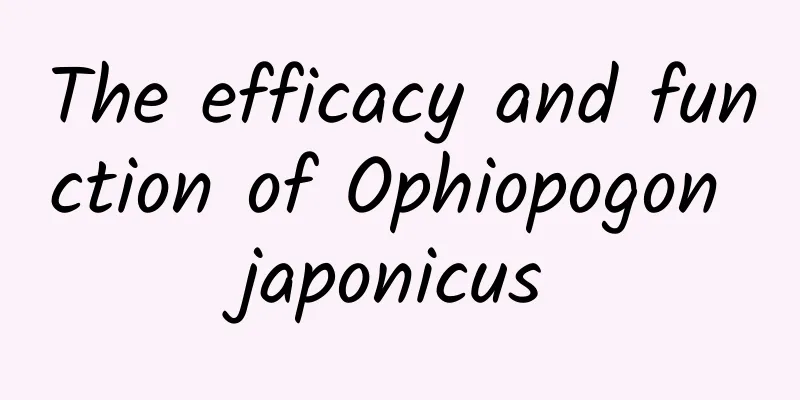The efficacy and function of Asparagus cochinchinensis

|
For Chinese medicinal materials such as Asparagus cochinchinensis, we should first understand its medicinal value and precautions before consuming it. The following is an introduction about Asparagus cochinchinensis. I hope you can read it carefully, which will be of great help for your consumption. [Alias] Da Dang Men Gen (Shi Yao Er Ya), Asparagus cochinchinensis (Yao Yao Hua Yi). [Source] It is the tuberous root of Asparagus cochinchinensis, a plant of the Liliaceae family. It is harvested in autumn and winter, but the quality is better in winter. After digging them out, wash off the soil, remove the fibrous roots, separate them according to size, and cook or steam them in boiling water until the skin can be easily peeled off. Take out and soak in clean water, remove the skin while hot, wash, dry on low heat or fumigate with sulfur and then dry. [Original form] Asparagus cochinchinensis, also known as: Dian Le (Ben Jing), Wan Sui Teng, Po Luo Shu (Jiu Huang Ben Cao), Tian Ji (Compendium of Materia Medica), Bai Luo Shan (Illustrated Catalogue of Plant Names and Realities), Duoer Mu, Ba Bai Zai, and Si Dong. [Habitat distribution] Grown in mountains and fields, and also cultivated in gardens. Distributed in central, northwest, Yangtze River basin and southern my country. It is mainly produced in Guizhou, Sichuan and Guangxi. In addition, it is also produced in Zhejiang, Yunnan, Shaanxi, Gansu, Anhui, Hubei, Henan, Jiangxi and other places. Guizhou has the largest output and the best quality. [Properties] The dried root tuber is oblong spindle-shaped, plump in the middle and tapering and blunt at both ends. It is 6 to 20 cm long and 0.5 to 2 cm in diameter in the middle. The surface is yellowish white or light yellowish brown, oily and translucent, sometimes with fine longitudinal lines or grooves, and occasionally with yellowish brown outer skin that has not been removed completely. The completely dried ones are hard and brittle, while the wet ones are soft and sticky. The cross-section is waxy, yellow-white, translucent, and has an opaque white core. It has a slight odor and tastes sweet and slightly bitter. The best ones are plump, dense, yellow-white and translucent. The strips that are thin and long, yellowish-brown and dull in color are of inferior quality. 【Pharmacological action】 Anti-tumor effect [Processing] Pick out impurities, wash with water, and soak until the moisture inside and outside is evenly distributed. Cut into sections and dry. 【Nature and flavor】 Sweet, bitter, cold. [entry into meridians] Enters the lung and kidney meridians. 【Functions and indications】 Nourishes yin, moistens dryness, clears the lungs and reduces heat. Treats yin deficiency fever, cough and vomiting blood, pulmonary emphysema, lung abscess, sore throat, thirst, and constipation. [Usage and Dosage] For oral use: decoct in water, 2 to 4 qian; make into paste or make into pills or powder. [Note] Those suffering from diarrhea due to deficiency of cold and cough caused by external wind and cold should not take this medicine. [Additional prescription] ① For treating cough: Ginseng, Asparagus cochinchinensis (without the core), and Rehmannia root in equal parts. Grind it into fine powder, add refined honey to make pills as big as cherries, dissolve them in the mouth and take. (Sancai Pills from "Rumen Shiqin") 【Clinical application】 ① Treatment of breast tumors [Remarks] The tuberous roots of plants of the same genus, such as Asparagus cochinchinensis (see the entry for Tubai Bu) and Asparagus microphylla (distributed in Yunnan), are also used as medicine as Asparagus cochinchinensis in a few areas. 【Excerpt】 《*Dictionary》 [Source] From "Shennong's Herbal Classic". Through the introduction in the above article, I believe everyone has a certain understanding of Asparagus. Asparagus has a great effect and is very beneficial to the human body. Therefore, everyone can choose Asparagus according to their physical condition, but it should still be done under the doctor's advice. |
<<: The efficacy and function of Tianmingjing
>>: The efficacy and function of Tianluo water
Recommend
JiWire: Half of mobile users are willing to use mobile terminals to purchase goods worth more than $100
Research shows that mobile phone users are more r...
Experts reveal the truth about 9 major rumors about osteoporosis
Medical data show that 50% of osteoporosis patien...
Is the Laniakea Supercluster, composed of 100,000 galaxies, the largest structure in the universe?
What is the world to a person? Is it the Earth? N...
This National Day, the Xinjiang lamb skewers you eat may contain Zhejiang technology
As the National Day is approaching, more than 2,0...
Do you need to absorb the oil when eating instant noodles? Is oil-absorbing paper safe?
Recently, a magical operation of "absorbing ...
How come calamine lotion, which costs only a few dollars a bottle, has become the “all-round anti-itching drug”?
Speaking of calamine lotion, many people may be f...
The efficacy and function of cotton ginseng
In our lives, Cotton ginseng has attracted our at...
Contraindications of Shaoyao Gancao Decoction
As people age, their body functions will graduall...
The vibrant green is actually the color of death?
This painting, in bright green, makes the whole r...
Parents and pigeons are superstitious...
After stepping on a manhole cover, I quickly aske...
How to repay the "sleep debt" incurred by working night shifts for a long time?
It is normal for medical staff to stay up late at...
International Archives Day: Take a look at the wonderful journey of these precious archives →
Archives connect the present and the past, and ca...
Shock! Is the "skin-beautifying" baby cream actually a devilish trap for your baby's health?
An incident previously exposed on the Internet ca...
The role and efficacy of Gorgon Fruit
Gorgon fruit is very important to people and is a...
The efficacy and function of gypsum
Gypsum is a common item in our lives. It has many...









